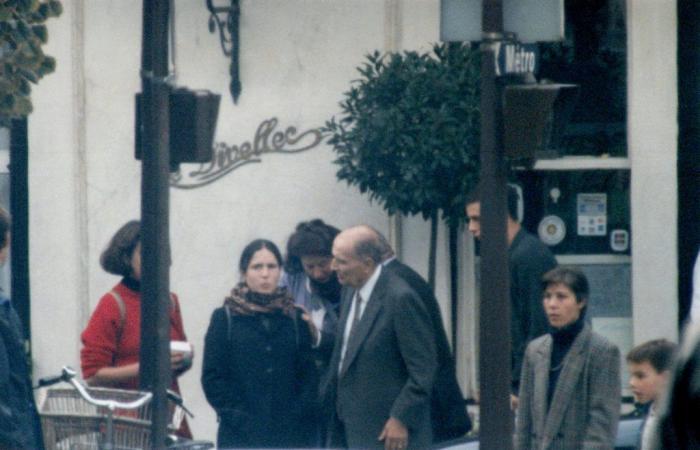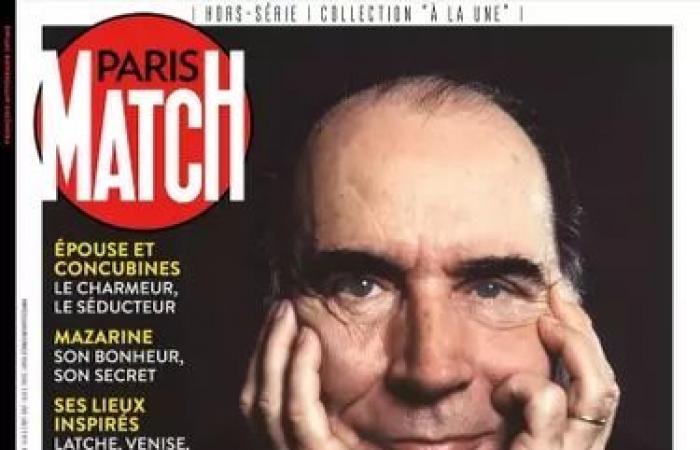(This article was originally published in the Paris Match Special Issue “Mitterrand Intime”, published on May 1, 2021.)
It all starts with one of those tips that turn the hunt for a scoop into a lucky day, something the paparazzi are fond of. In the wake of the “star bracos” there arise, in fact, makeshift informants. And sometimes by chance. This is the case on this morning in September 1994…
Not only do Pascal Rostain and Bruno Mouron (the bosses of the Sphinx agency), a duo without rivals in the exercise of the good hideout, have confirmation that François Mitterrand shelters his morganatic family – which passed for an urban legend – in a “ palace” of the Republic, quai Branly, but they learn that Mazarine, hidden daughter of the president, has kept the moorings of her childhood, rue Jacob, in the heart of Saint-Germain-des-Prés.
An existence already known to journalists
Daughter of Anne Pingeot, an Auvergne of (very) good lineage, and François Mitterrand, brooded by Commander Prouteau’s Presidential Security Group (GSPR), Mazarine is the object of more than one fantasy. As if in (very) supervised release, she grew up under the seal of state secrecy.
Setting himself the challenge of revealing this secret, Jean-Edern Hallier, a man of letters and a bard of great winds, eternally rejected at the steps of the French Academy, draws his pen to flush out the beauty. Apart from “The International Idiot”, a literary firestorm where he cultivates tons of enmity (and legal problems), “Edern” has set out to hunt down the innocent Mazarine. In his quiver, his feathers are arrows.
The rest after this ad
Pipped by Jack Lang to the position of the Ministry of Culture for which he was running (without much chance, it is true), he composed a pamphlet whose title is intended to be a literary vendetta: “The lost honor of François Mitterrand. » Nineteen publishers refused it. But now Philippe Alexandre, a gently mocking voice on the airwaves of RTL, discreetly takes over and refines an “Impossible Plea” of close quality.
From the Mazarine mystery, which has already inspired Françoise Giroud’s novel – “Le Bon Plaisir”, published by… Mazarine, in 1983 – and nourished the dinners in town of the Parisian golden triangle, the revelation of the double life of Mitterrand n It’s more than a matter of weeks, or even days…
Gone are the days when only the right-wing satirical weekly “Minute” and the monthly “Le Crapouillot” tickled the curiosity of the media class with their veiled photo briefs. Mazarine, it is true, was then a minor. And unknown to most people. Flashback…
One of Paris Match from November 10, 1994.
© DR
Track down one scoop to collect another
Between hideouts and spinning mills, Sébastien Valiela and Pierre Suu, collaborators of the Sphinx agency, trace the trace of Isabelle Adjani whom her British boyfriend, the actor Daniel Day-Lewis, has just left. His post-breakup melancholy is a boon for the celebrity press. So here they are, pacing back and forth under its windows, rue de Varenne. Soon a shopkeeper spots them.
She takes them for police officers:
“Are you cops?
– No, photographers. »
Big smile from the lady:
“How lucky! My son dreams of becoming a reporter. Shall I present it to you?
– Of course ma’am. »
The young man had barely extended his hand to them when they heard him say:
“Are you looking for Mazarine? »
Like old image hunters, they feign innocence:
“Mazarine? You mean?…. – Yes, Mazarine, Mitterrand’s hidden daughter. »
Without knowing it, shoeing the beautiful Isabelle, they are bringing back something heavy, very heavy even, as they say in the jargon. In short, the scoop of scoops.
The rest takes place in a competition of long-term monitoring, classic spinning, hazards and more or less lucky veins until the day when… It is September 21. A certain excitement agitates the streets which border Saint-Germain-des-Prés. These hurried passers-by look like extras from a detective film. In fact, they are real cops.
September 21, 1994: the pursuit in the streets of Paris
And here is Mazarine herself, her hair in a bun revealing the oval of her face. Followed by Ali, her companion, leg in a cast, limping, and a friend, she rushes into a car immediately surrounded by an unmarked white 205 and a GSPR van. Sébastien and Pierre get on their scooter and follow the procession: rue Jacob, rue de l’Université, to the National Assembly.
Then she continues on foot towards Les Invalides. Valiela takes her lead, Suu follows at a distance, on two wheels. It was by seeing the massive silhouette of Pierre Tourlier, François Mitterrand’s ponytail driver, parked in front of the Divellec restaurant, that the paparazzi guessed the importance of the meeting.
No doubt: Mazarine joins his father, a lover of seafood and noble fish, familiar with this starred restaurant, one of the establishments frequented by all of Paris’ politicians. The two scoop hunters, armed with a powerful telephoto lens – a 1,200 mm – immediately set up on the terrace of the Air France terminal, on the other side of the esplanade to watch for their prey… They are all in on the balustrade, for an hour and a half, worried about the police patrols on mopeds, but also, blocking the view, of the buses which screen in front of the restaurant door.
According to a pre-established ritual, Mazarine leaves in front of her mother, Anne Pingeot, who has come by bike. Then here is Michel Charasse, former minister and close friend of the clan. Miraculous moment where, under the gaze of Breton chef Jacques Le Divellec, in an apron, the “mystery” family is reunited. The photographers shoot. Banco! It’s in the box.
Present the photos to Paris Match
Discreetly, their bosses, Pascal Rostain and Bruno Mouron, developed the incredible photos in an anonymous Photo Service, avenue George-V. Then they show up at Paris Match with small prints, 9 x 15 centimeters. From Michel Sola, photo editor-in-chief, to Patrick Jarnoux, head of news, it’s astonishment.
Then comes the time of Roger Thérond, the emblematic director, nicknamed “the eye” by the profession. Daniel Filipacchi himself, owner of the title – and of the press group –, always a journalist at heart since his beginnings at Match, completes the circle. Because the time has come for “the responsibility to publish”. Or not.
Let it be known at the Élysée
It is first a matter of taking an unofficial approach, so that it can be said, later, that at the Élysée “we knew”. An appointment is made with Roland Dumas, lawyer and litigator, former minister of state, close friend of the president. Facing him, Frank Ténot, number 2 of the group and subtle business negotiator. A lunch brings them together at Le Pichet, rue Pierre-Charron, under the very windows of the editorial office. Table 7, out of sight, on the left as you enter, the same one where the president sometimes sits at a table with his sons or friends, Ténot and Dumas begin the discussion around a Château Ducru-Beaucaillou, a Grand Cru Classé from Saint-Julien, in Bordeaux.
From a large format envelope, Ténot takes out a handful of photos, creating an imperceptible movement of embarrassment in Dumas. The latter quickly realizes that the publication of these photos risks triggering a scandal in the Mitterrand family but also in the public. He doubts that the president will be able to confront him. In fact, he is recovering from an operation at Cochin hospital. He is still weakened. Frank Ténot simply argues: “If it’s not us, it will come out elsewhere… It’s sure, it will come out. »
I’ve had enough! My privacy is being attacked. Make a referral.
François Mitterrand
The two men separate at a sort of impasse, full of things left unsaid. Later, Dumas confessed to François Mitterrand’s spontaneous reaction: “I’ve had enough! My privacy is being attacked. Make a referral. » Dumas weighs the pros and cons: a summary judgment against Paris Match and the Mitterrand-Mazarine secret immediately turning into a matter of state! Not so simple…
He seeks the advice of Robert Badinter, another friend and former Minister of Justice of François Mitterrand, who is left speechless: “Deal with it! » As for the president of the Paris high court, she replies: “Seizing a newspaper is annoying, don’t you think? »
Finally, exhuming a statement from François Mitterrand himself – “We should never seize a newspaper or attack a journalist”, during the trial of Jacques Laurent in 1965, then prosecuted for his pamphlet “Mauriac sous de Gaulle” –, Roland Dumas backtracked. He plays the negotiation card, amicably, and cites the fact that Mazarine, a young student, has back-to-school exams to pass.
The information is circulating in Paris. Those who took the photos risk offering them to others.
Frank Ténot
Time passes, indeed. Paris Match does not publish anything. Dumas doesn’t say anything anymore either. Neither yes nor no. Daniel Filipacchi and Frank Ténot take his silence for a tacit agreement, especially since a little sentence, emerging from behind the scenes at the Élysée, is making the rounds of the editorial staff: “The press knows what it has to do” , quickly attributed to Mitterrand, who never denied it.
After a few quiet avatars, the specter of publication returns in force. Dumas, a little sheepish, calls back Ténot, who replies firmly: “Listen, the news is circulating in Paris. Those who took the photos risk offering them to others. It is better to master the subject than to endure it and see it appear without weight. » So Stéphane Denis, journalist and writer, is entrusted with a courtesy embassy.
Then, Roger Thérond entrusted me with contacting Paulette Decraene, the president’s highly trusted secretary. I call her on a Saturday at her place because the publication date is now imminent. Meet at the Le Bristol hotel bar. Like Frank Ténot before Roland Dumas, five weeks earlier, Match’s emissary, I gave a confidential envelope to the faithful collaborator. Inside are photos of Mazarine and her father, of course.
November 10: we publish
From then on, François Mitterrand admits that the countdown has started. At Match, it remains to find the ideal shooting window. The director of the newspaper chooses All Saints’ Day. For what ? To benefit from the public holiday, a Tuesday. Result: no risk of referral that day and no need for an embargo on the number when printing.
The half-dozen dedicated pages, beyond a moving report on the president facing illness, are “cooked up” in secret, in an apartment that was very familiar to me, at 9, rue Lincoln, with an editorial team ultra-reduced: three people, including the artistic director. Thursday, publication day. The photo of Mazarine and his father appears under the Match logo. The president, alone, serious and sunken face occupying most of the front page. The title, “Mitterrand and his daughter”, and the subtitles, “The moving story of a double life. Photos: the tenderness of a father”, snaps. France is stunned and the newspaper is torn up.
Faced with the disclosure of this family secret, François Mitterrand, relaxed, displays sincere serenity. He will have this sentence: “It’s like psychoanalysis. » Roland Dumas, as if reassured in his turn, clarified his thoughts: “The object of the analysis is to confront the person concerned with reality. So that was the reality. »
And the paparazzi in all this? Revealed in full light, even without her knowledge but ultimately for her happiness, Mazarine will almost become friends with Valiela and Suu, for the duration of a photo shoot, under the Pont-Neuf. An “official” exclusive for Paris Match, eight months later, in July 1995. Happy End.
Click on the image below to purchase the Special Edition
“Intimate Mitterrand”, Paris Match Special Issue, May 1, 2021.
© DR







